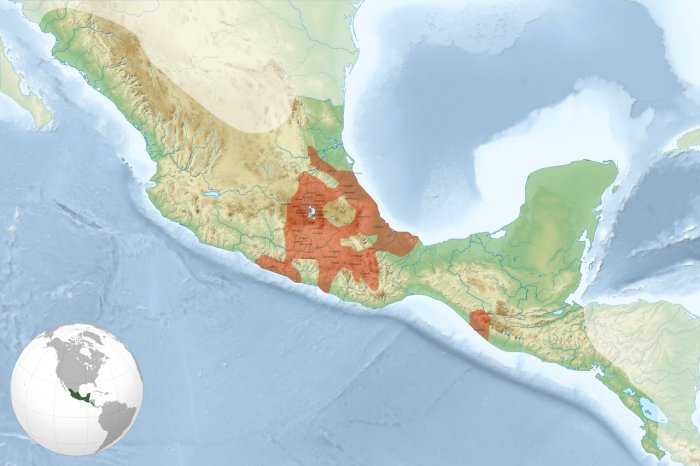Jan Bartek – AncientPages.com – The Aztecs, also called the Mexicas, were renowned for their prowess in warfare and conquests. However, the economic networks, rituals, and political influence of the Mexica Empire also heavily relied on the trade of ancient obsidian artifacts. Archaeologists have uncovered how obsidian—a volcanic glass used for tools and ceremonial objects—was a crucial raw material in pre-Columbian times. This material moved extensively across ancient Mesoamerica and significantly shaped life in Tenochtitlan, the empire’s capital.
Credit: Gary Todd – CC0, Maunus – CC BY-SA 3.0, image compilation by AncientPages.com
In a comprehensive study, scientists analyzed 788 obsidian artifacts excavated from the Templo Mayor of Tenochtitlan—the main temple at the heart of the Mexica Empire, located in present-day Mexico City. This research, conducted at Tulane University and the Proyecto Templo Mayor in Mexico, marks the most extensive compositional study of obsidian conducted at this site.
The research was made possible through a partnership between Tulane and Mexico’s Proyecto Templo Mayor of the National Institute of Anthropology and History (INAH), with artifacts analyzed using portable X-ray fluorescence (pXRF), a non-destructive method that identifies the geochemical fingerprint of each artifact.
The Aztec empire in 1519 during the reign of Moctezuma Xocoyotzin or Moctezuma II. Credit: Aldan-2 – CC BY-SA 4.0
Findings revealed that while green obsidian from Sierra de Pachuca was predominantly used by the Mexica, they also sourced this valuable material from at least seven other locations. These included regions beyond their political borders such as Ucareo in Purépecha territory in West Mexico. The results indicate that their economy was not solely dependent on conquest but also thrived on sophisticated long-distance trade networks with rival polities.
“Although the Mexicas preferred green obsidian, the high diversity of obsidian types, mainly in the form of non-ritual artifacts, suggests that obsidian tools from multiple sources reached the capital of the Empire through market instead of direct acquisition in the outcrop,” said lead author Diego Matadamas-Gomora, a Ph.D. candidate in Tulane’s Department of Anthropology.
“By studying where this material came from, we can explore the movement of goods across Mesoamerica.”
The analysis revealed that nearly 90% of the obsidian artifacts in the sample were crafted using Sierra de Pachuca obsidian, valued for its distinctive green hue and its symbolic ties to the mythical city of Tollan. This type of obsidian was predominantly used in ceremonial artifacts found within buried offerings at the Templo Mayor, including miniature weapons, jewelry, and sculpture inlays.
A smaller yet noteworthy portion of obsidian originated from regions such as Otumba, Tulancingo, Ucareo, and El Paraíso—areas sometimes beyond the Mexica Empire’s control. These materials were primarily utilized for tool production and discovered within construction fill. This suggests that these types of obsidian were accessible to the general populace through local markets rather than being strictly regulated by state authorities.
Obsidian plates at the Museo de Arte Popular, Mexico City. Credit: Thelmadatter – CC BY-SA 3.0
The study also examined changes in obsidian use over time, spanning from around 1375 CE during the city’s early phases to its decline in 1520 CE. Initially, there was greater diversity in sources for both ritualistic and everyday items. However, following the Mexica’s consolidation of power around 1430 CE, ritual use became almost exclusively reliant on Sierra de Pachuca obsidian. This shift indicates an increase in religious standardization and centralized control over resources.
“This kind of compositional analysis allows us to trace how imperial expansion, political alliances and trade networks evolved over time,” Matadamas-Gomora said.
See also: More Archaeology News
“This work not only highlights the Mexica Empire’s reach and complexity but also demonstrates how the archaeological sciences can be leveraged to study ancient objects and what they can tell us about past cultural practices,” said study co-author Jason Nesbitt, an associate professor in Tulane’s Anthropology Department.
The study was published in the journal Proceedings of the National Academy of Sciences
Written by Jan Bartek – AncientPages.com Staff Writer




